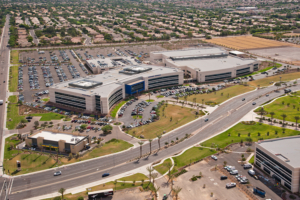Q&A with NAIOP-AZ President Tim Lawless
Q: A year ago you cited several factors that needed to occur for the regional economy to get going again. Have those changes occurred and what impact have they made, if any, in regard to the outlook of local commercial real estate?
Last year, I said that four things needed to occur before we could get on our feet again as an industry. They were:
1) credit markets need to act more normally;
2) job losses need to stabilize;
3) the glut of housing inventory needs to be absorbed so folks can sell their homes in the Midwest and California and continue to migrate here; and
4) we need a more competitive state tax code and to enact policies that diversify the economy in order to attract the flight of capital and brainpower, especially from California.
The credit market is not yet normal. People are still hoarding cash and there is an expectation that hundreds of banks nationwide will still fail when they take further haircuts on distressed properties that have yet to move into the barber’s chair.
We have stabilized job losses, but the rebound is much slower than hoped and few think we will replace all the jobs lost even after 5 years in our state. Nationally, many of these jobs will never come back. They are in India and other countries.
Regarding the glut of homes available, we are seeing some activity that gives hope, but I wouldn’t “bet the house” on it recovering just yet.
And finally, we have done little to nothing regarding the tax code besides talk about privatizing a Department of Commerce and enacting a solar tax credit that only helps on the far periphery. If anything, we have gone backwards as business has had to absorb two major tax increases with the prospect of more coming.
Of the four things, the job losses and housing are the most improved, while we are still waiting for the brunt of commercial property foreclosures to move through the system. Once the foreclosure “pig” is digested in the “python,” the credit markets will be more normal. This digestion, however, is soon upon us, which becomes necessary for recovery.
The factor that holds the least optimism is the prospect of changing our uncompetitive business tax code, especially as it relates to high commercial property taxes. Perhaps this can only be accomplished in tandem with yet another tax increase as the political courage to further cut spending has waned.
The silver lining about all of this is that properties are fast becoming a bargain and a lot of cash on the sidelines may soon come in.
Using a baseball analogy, we are in the late innings regarding a residential property recovery, and perhaps only in the mid-innings regarding a commercial property recovery. What we all hope to avoid is the prospect of extra innings through a double dip.
Q: What are some of the new challenges you see facing the industry in 2011?
While it was anticipated that at least one major tax increase would occur (two in fact occurred, the reinstitution of the $250M per year state equalization property tax and the $1B per year sales tax increase) the prospect of multiple tax increases at either the federal, state or local levels is the new challenge.
The feds seem intent on taxing commercial partnerships more like ordinary income rather than the lower capital gains tax treatment, while the state’s structural budget deficit will be more than a billion dollars beyond 2014. The locals will also be eying ways to raise revenue, most likely via the property tax rates.
Multiple tax increases on small businesses that are tenants in our buildings and at financial risk will only result in more potential vacancies if not more rent concessions. Further tax burden increases will also harm our ability to attract more firms to our state.
Q: How do you envision NAIOP-AZ helping to address those challenges?
NAIOP-AZ will continue to advocate at the state Capitol for a more competitive tax code that creates more high-paying jobs for our economy. Besides advocating for property tax reform, we also are now advocating a corporate income tax rate reduction and a deal-closing fund for the governor in order to attract more firms and allow existing firms to expand.
Q: What are some opportunities you foresee in the industry in 2011?
As the foreclosures and the sale of distressed properties mount, this creates the opportunity for more out-of-state entrants to become active in our community. In other words, the companies that were well known before will be replaced by new firms that may re-charge our communities and have the potential to provide new perspectives.
This is the essence of the rising Phoenix myth and the image of Arizona that most Americans have — that it is an egalitarian state where one rises and falls on their merits and where even a desert can be remade into an oasis.
Q: What are some NAIOP-AZ initiatives for the coming year?
During an economic downturn, the key is to do more with less. Our trade association is not immune, as many of our members have lost their job or taken new jobs for less pay in the last year. As a result, we are trying to offer more networking and educational opportunities.
A key example is the institution of a Market Leaders Sunrise Series. We invite our membership to hear from industry panels that are experts in certain fields such as lending, economic development, brokerage or “green” initiatives.
We also have attempted to pursue strategic alliances with other trade associations, where we can co-leverage resources toward more bang for the membership buck. An example is we plan to co-sponsor ULI’s Trends Day in January, where our members may get a reduced fee for attending. We also have partnered with BOMA-AZ in offering multiple continuing education courses.
Internally, we are looking at pursuing a mentoring program, where individual board members would partner with commercial real estate professionals 35 years of age and under from our Developing Leaders Committee.
In closing, we would be remiss in not thanking our corporate sponsors and members who have made our trade association a relevant force in public policy advocacy and in providing a platform for education, networking and philanthropic involvement.




